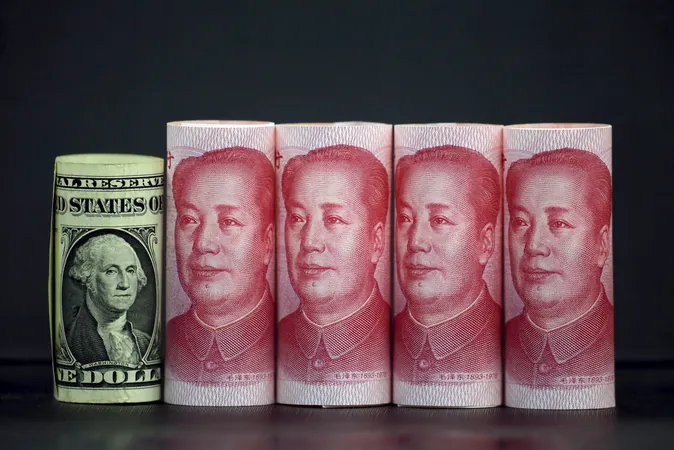
Is the Yuan Set to Take the Crown? Behind China's Push for Global Currency Dominance
2025-09-12
Author: Yu
In a move that could reshape the global economic landscape, U.S. President Donald Trump's recent policies may be inadvertently paving the way for the Chinese yuan's ascendance as a dominant global currency.
While the U.S. dollar currently reigns supreme, making up over 58% of central bank reserves, the yuan's presence is growing, albeit from a modest starting point of around 2%. As Trump's administration grapples with increasing tariffs, a ballooning national debt nearing $38 trillion, and tensions with the Federal Reserve, China is quietly crafting a strategic framework to elevate the yuan's status.
The Rise of CIPS: China's Financial Infrastructure
Central to this strategy is the Cross-border Interbank Payment System (CIPS), which has seen a staggering 43% increase in transactions last year alone, totaling $24.5 trillion. This indicates not only a growing acceptance of the yuan but also a robust infrastructure designed to facilitate its use in international trade.
The People's Bank of China (PBOC) is expanding the reach of CIPS and developing a global currency-swap network—establishing numerous yuan-based swap arrangements worth about $632 billion over the past 17 years, as nations like New Zealand jump on board.
Global Institutions Jump on the Yuan Bandwagon
Offshore institutions are increasingly authorized to clear yuan transactions, marking a significant shift in global financial dynamics. Bank of China (Hong Kong) Ltd has emerged as a leader in this space, processing nearly $530 billion in settlements, helping to connect China with its trading partners worldwide.
Moreover, JPMorgan Chase and Japan's Mitsubishi UFJ have been granted permission to facilitate yuan transactions, enhancing liquidity and creating direct connections between Beijing's financial system and international markets.
Opportunities amid U.S. Policy Chaos
While the dollar remains strong, a series of challenges—for instance, rising U.S. debt and Trump’s confrontational trade policies—are igniting a crisis of confidence in the greenback. Some analysts predict that the dollar will face its worst performance in decades in 2025, with calls for increased tariffs further dampening its appeal.
This turmoil offers China a golden opportunity. With major state-owned lenders like Bank of China and China Construction Bank leading the charge for yuan-denominated services, Beijing is becoming increasingly integrated in the regional and global economies.
A Currency Under Pressure: Potential Risks Ahead
However, rising yuan internationalization isn’t without its risks; a weaker yuan may provoke aggressive responses from the Trump administration, potentially triggering tensions in U.S.-China relations. Notably, any unchecked depreciation might lead to capital flight and further destabilize China's economy.
Experts warn of a looming currency war if inequalities in trade relations escalate. Trump’s tariffs could backfire, compromising U.S. economic health by inflating costs and diminishing demand for Chinese products at a time when the nation is already battling low retail sales.
Conclusion: The Yuan’s Future in a Changing Landscape
While Trump's tax cuts and trade barriers may seem beneficial in the short term, they could entrench America’s reliance on the savings of global partners, including China. As inflation creeps up due to these policies, the stage is set for the yuan to capitalize on the dollar's vulnerabilities.
The story unfolding in the financial world resonates with potential shifts in power dynamics, as China’s meticulous groundwork expresses a readiness for global currency leadership. It remains to be seen how these strategies will play out, but all eyes will be on the yuan as it inches toward a new era.



 Brasil (PT)
Brasil (PT)
 Canada (EN)
Canada (EN)
 Chile (ES)
Chile (ES)
 Česko (CS)
Česko (CS)
 대한민국 (KO)
대한민국 (KO)
 España (ES)
España (ES)
 France (FR)
France (FR)
 Hong Kong (EN)
Hong Kong (EN)
 Italia (IT)
Italia (IT)
 日本 (JA)
日本 (JA)
 Magyarország (HU)
Magyarország (HU)
 Norge (NO)
Norge (NO)
 Polska (PL)
Polska (PL)
 Schweiz (DE)
Schweiz (DE)
 Singapore (EN)
Singapore (EN)
 Sverige (SV)
Sverige (SV)
 Suomi (FI)
Suomi (FI)
 Türkiye (TR)
Türkiye (TR)
 الإمارات العربية المتحدة (AR)
الإمارات العربية المتحدة (AR)